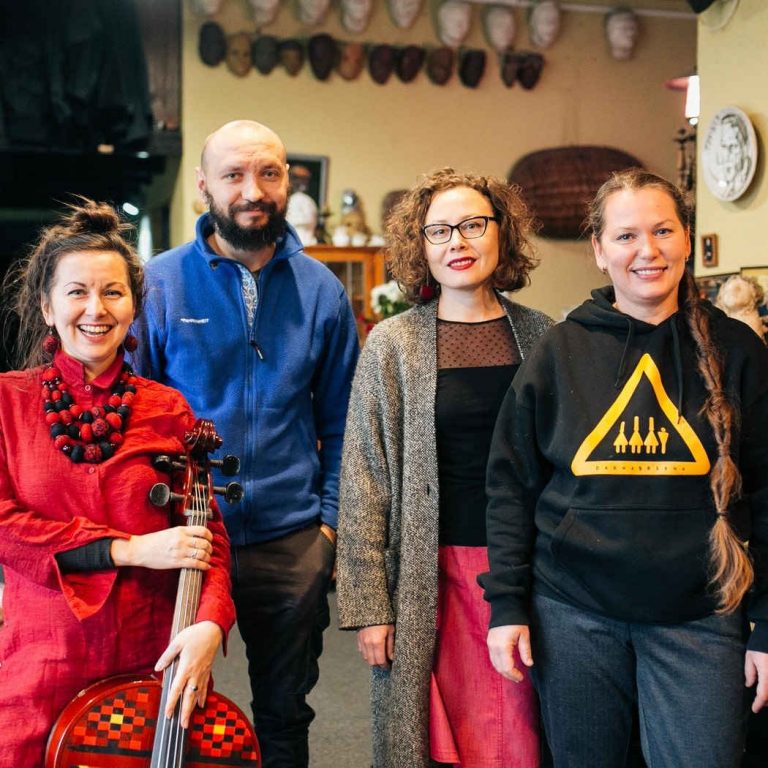In the ‘Ambassadors’ project, famous Ukrainians take us on a walk around their hometowns, introducing us to special places along the way. In the 15th episode, the members of ethno-band DakhaBrakha share their vision of Kyiv, a city rich with history and buzzing with modern life.
Ukraїner founder Bogdan Logvynenko set off with the musicians to explore Ukraine’s multidimensional capital.
The band DakhaBrakha formed at the beginning of 2000 within the walls of the Dakh Centre of Contemporary Art, on the initiative of Vlad Troitskyi, the band’s creator and art director. DakhaBrakha is comprised of four musicians: Iryna Kovalenko, Olena Tsybulska and Nina Haranetska got into the Dakh Theatre thanks to their university friend, Valeriy Hladunets. Back then, Valeriy was part of the ‘Bozhychi’ vocal ensemble and working with the theatre. The band’s fourth member, Marko Halanevych, joined the Dakh Centre’s theatre school, and soon also started participating in musical experiments with folklore. These explorations and experiments with folk art all led to the creation of DakhaBrakha.
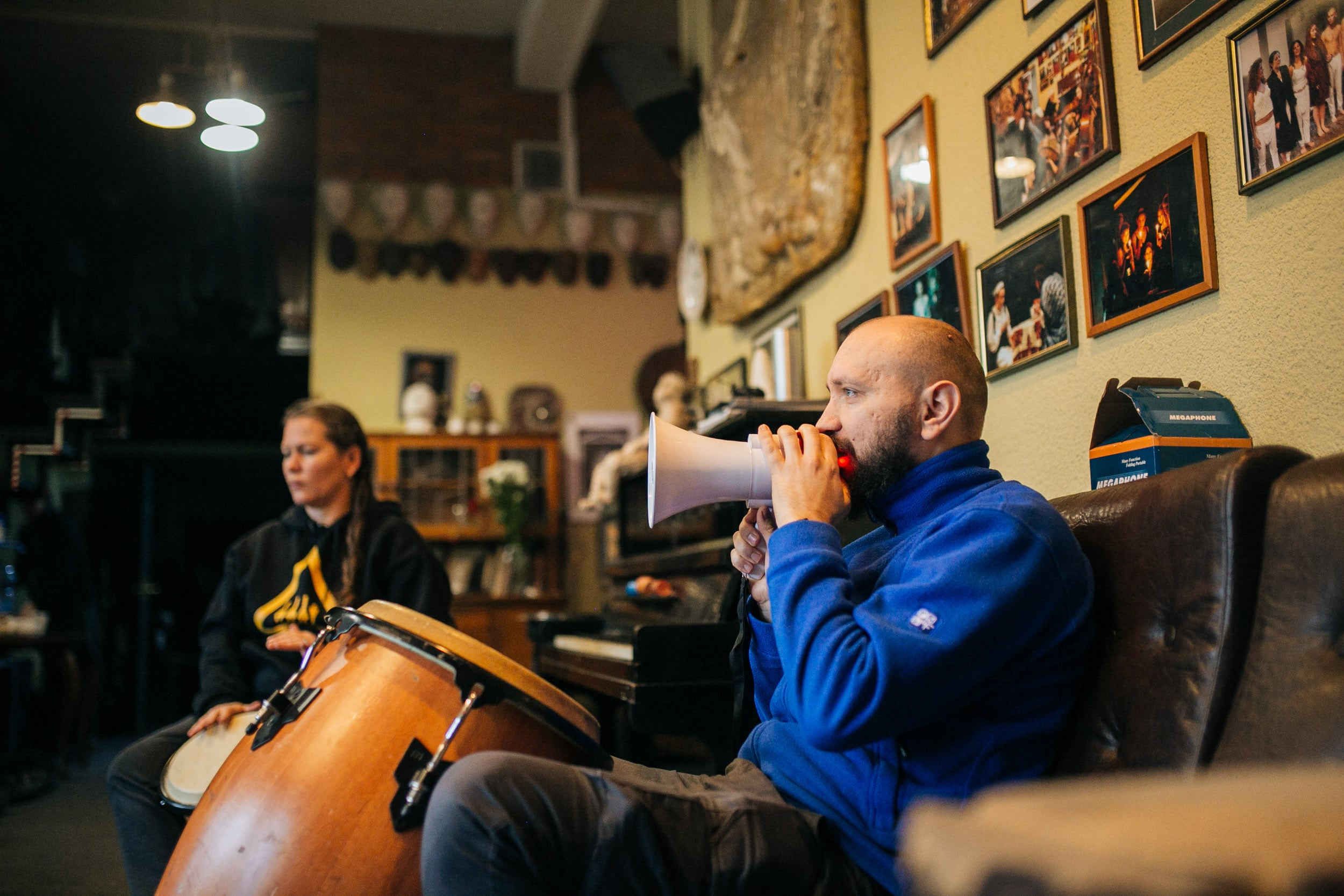
Marko
— You don’t live in the centre of Kyiv, do you?
— I live 60 kilometres from the city. Most of my friends prefer Podil (a district of Kyiv — ed.), but I much prefer the city centre.
— Where are you from originally?
— I was born in Vinnytsia region, but I finished school in Kherson region because my parents moved there when I was 9 years old. I badly wanted to move to Kyiv, to the big city: I visited a couple of times and loved it. When I came here for university, I started exploring everything around me, looking for interesting places. Then I started organising tours for Kyivans.

Orthodox. Books/Coffee/Illustration is a gallery with its own coffee shop and bookstore, founded in order to introduce visitors to the work of Ukrainian illustrators and graphic artists. It opened in 2017 and is Kyiv’s first gallery for illustrators. Here, illustration mediates between spectator and author, opening up a space for creative discussion.
— How long have you been drawing?
— Since school: I used to sit and draw in my lessons, and then in my lectures at university. Drawing helped me to memorise the material. Then Vlad Troitskyi asked me to do some drawings as part of the video art for our concerts. That’s when I got serious about it, and decided to buy a graphics tablet.
— When did you get into music?
— I sang for about a year and a half in the ‘Dnipro’ chapel. It was a bit difficult, since I hadn’t had a musical education and couldn’t read music. It was mostly just a guessing game for me. Then I came to DakhaBrakha and it was the same story.

Since 2014, painters from Ukraine, Spain, Argentina, Australia, Germany, Portugal and other countries have embellished more than 100 buildings in Kyiv with murals. Prior to that, the capital’s facades were mostly covered in advertising. The duo Interesni Kazki, who enjoy fame well beyond the borders of Ukraine, were some of the first artists to create conceptual murals in Kyiv.
Oleh Sosnov, the manager of cultural projects at the Institut Français of Ukraine, supervised the creation of some of the murals, including ‘St. George’, ‘Time of Changes’, and the portrait of Serhiy Nihoyan. Oleh believes that street art is relevant not just to the city centre, but also in residential districts, where old buildings in need of restoration can serve as canvases for creativity: “At the beginning of the 2010s I was organising shoots for the French artist Julien Malland, who was travelling the world and meeting with local street artists. I realised there were many talented artists who had no opportunity to make art because of the lack of infrastructure, funding, understanding, and supervision. I had the opportunity to invite Malland to Ukraine to work on a joint project with a Ukranian artist. As a result, in 2012, the mural ‘Vita sine litteris mors est’ appeared on the campus of Kyiv-Mohyla Academy, created in cooperation with Interesni Kazki.”
— How did you meet Oleh?
— He worked at the Institut Français of Ukraine supervising art projects. We worked together there a couple of times and got to know each other. Oleh is a curator with a fine perception of art. He supervised the creation of some of the murals in Kyiv: in my opinion, the most successful ones.

— How did you get to know Vlad Troitskyi?
— There was a play, ‘Odd One Out’; my wife-to-be went to see it and was really impressed with the theatre. We started going to see a lot of performances, and then we got to Dakh and everything turned upside down. We saw that people could talk normally in the theatre, without any shouting or overexaggerated waving of arms. Then there was a rumour about a Dakh theatre school, and I decided to enrol. After my first conversation with Vlad, I understood that he was a person I could fully trust: that’s how well we clicked. The theatre is like another world; the relationships that are formed there are totally different
— How do you like working with so many women?
— It’s been a very natural milieu to me my whole life, and I’m not complaining. It has its quirks, but it’s nothing to grumble about. They’re my colleagues, first and foremost — it doesn’t matter to me whether they’re men or women. A couple of times I participated in events organised by HeForShe. I support what they say, what they promote: it suits me. That’s essentially how I live. We bring up our children together — I have two daughters. We cook together. I’m a happy man.
— Do people ask you for autographs when you travel by metro?
— No, it never happens, thank God. Maybe some people recognise me, but they don’t let on. I took my daughter to school and some of the boys were saying, “Hey, look, Dzidzio (popular Ukrainian band — ed.)! It’s Dzidzio!” So, yes, I guess I do get recognised.
He For She
An international campaign in support of gender equality.
The history of the Veterano Group began in 2015 when its founder, combat veteran Leonid Ostaltsev, came back to Kyiv. The goal of this social enterprise is to help Ukrainian military servicemen and women to adapt to civilian life after their return from the war. The Veterano Group consists of: a restaurant, ‘Veterano Resto’; a pizzeria, ‘Veterano Pizza’; a coffee shop, ‘Veterano Coffee’; a cake shop, ‘Veterano Brownie’; a security agency, ‘Veterano Guard’; a taxi service, ‘Veterano Cab’; and ‘Veterano Energy’, who install solar batteries.
Bohdan Chaban, a war veteran and the co-founder of Veterano Pizza, was one of the activists who took part in the pro-Ukrainian rallies in Donetsk in 2014, before the start of the occupation: “It was in Donetsk that I launched my first project in the restaurant business — it was a bar for hipsters called ‘Izba-chytalnia’ (‘Reading House’). In 2014, when it all kicked off in Donetsk, I took a radical pro-Ukrainian position; after a while, I was forced to leave the city. Then I went to serve in a volunteer military unit for a year and a half. After that, I got to know Leonid Ostaltsev while working on a new establishment in Mariupol. We had the idea that it would be cool to set up a little bar for our tough guys, our veterans.
“A few months later, Leonid told me he wanted me to become part of the team and take care of the bar project. So Leonid and I opened a restaurant here. It’s our flagship pizzeria, our place of power. It’s not only veterans who work here, because in order for people to adapt back into society, you need to have a mix of people: those who understand what you’ve been through, as well as those with different experiences. In order to train a great veteran-chef, you need to take a veteran and a great chef, and make them work together.”

— What is your favourite Ukrainian film?
— ‘Zemlia’ (‘Earth’, a 1930 Soviet film by Ukrainian director Olexandr Dovzhenko, for which DakhaBrakha has written a soundtrack — ed.). Nothing better has been made so far, but we have noticed some progress and movement. I’m very optimistic for Ukrainian cinema.
— What Ukrainian music do you listen to?
— I listen to ONUKA, Alyona Alyona… I can share them with my kid: it’s real quality stuff. I also listen to Hych Orchestra. They’re very authentic and original. Adam is amazing, he does music for young people, about love. Latexfauna, Tik Tu. From the older artists, I would name Zapaska. I can’t say we have anything underground that has sprung up recently. But I’m happy to be able to quote those names.
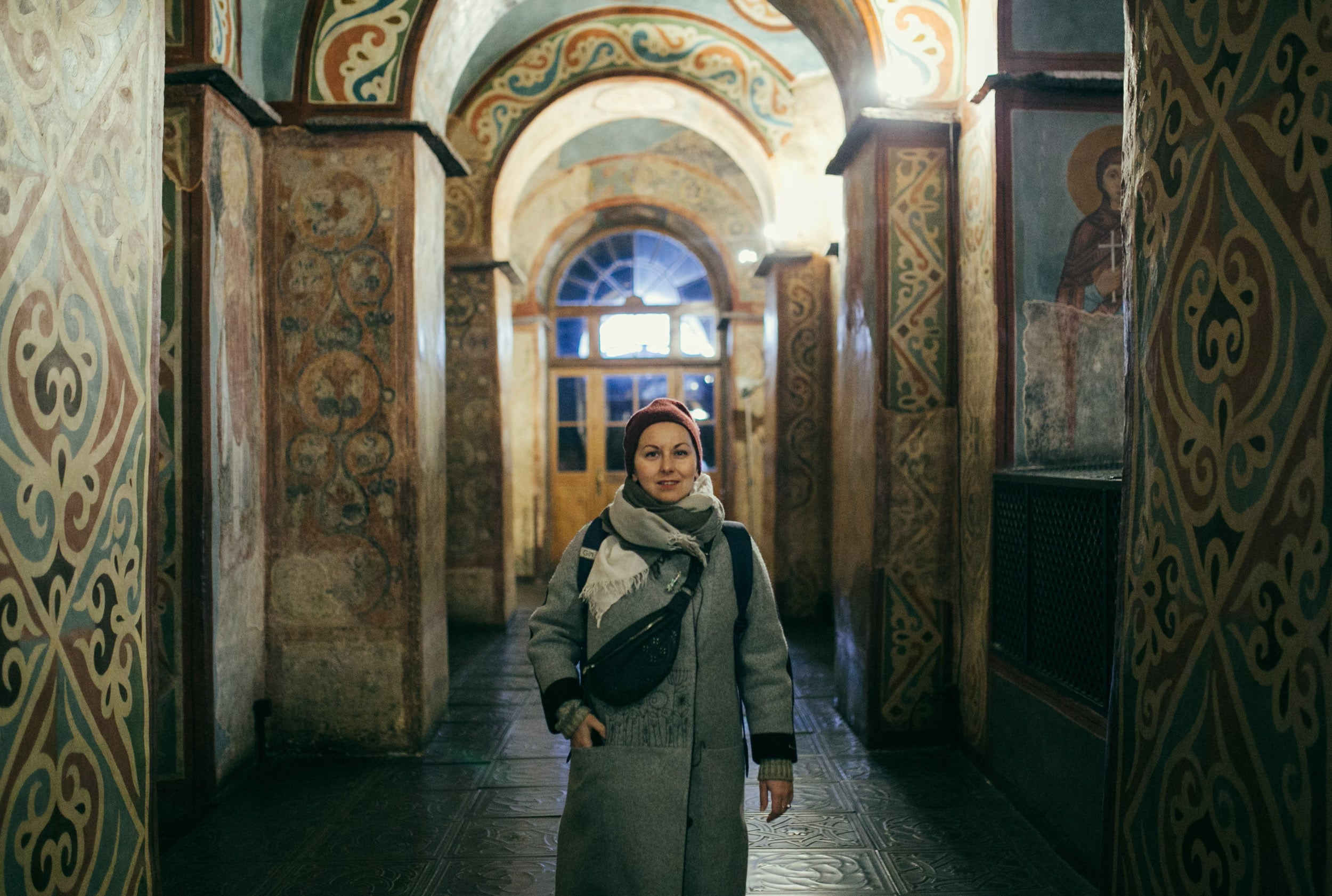
Nina
— Were you born in Kyiv?
— Yes, I was. It’s really weird, but I’ve never thought of myself as a Kyivan. For me, Kyiv is a place where I show up every once in a while. Lots of people tell me, “Oh my God, your city is beautiful,” and I answer, “At some point, I’ll definitely go there and manage to see something.” This has been going on for years. I always mean to go somewhere and see something, but every time I fail.
— So you know nothing about Kyiv?
— I’m a Kyivan and know nothing about Kyiv. I don’t go anywhere, don’t know anything. I mainly sit in my cave. Sometimes I come to repack my suitcase.
— Are there any special places for you?
— Sofiia Kyyivska (St Sophia’s Cathedral — ed.). It’s saturated with energy, all our knyazes are buried here. I like to come to Sofiivska Ploshcha during the New Year festivities, when they hold the New Year Fair. The air smells like mulled wine and sweets, there’s a Christmas tree — it’s so inspiring. I like that they use a location like this for concerts and fun at New Year, even if there’s no snow. Other wonderful events take place here, like ‘Bouquet Kyiv Stage’, a festival of high art. We took part in it this year (in 2019 — ed.). When we played there, we prepared a special programme and played beautifully, slowly, with a lot of soul.
Knyaz
Historical Slavic title denoting a noble rank.
— You can’t read music either, can you?
— I can, but I’m not a practising musician, who reads from sheet music during performances. If I practised all the time I’d be good at it, but I don’t do it regularly. I need a bit more time when I read sheet music.
— What do you think when your music is used in movies?
— We keep saying: “Take our music to use in movies, take it!” Our dream is to invite the American film director Jim Jarmusch to one of our concerts. Whenever we go to New York for a concert, we look for acquaintances who might know somebody who knows him. We believe, not so modestly, that our music would be a good match for his movies.
— What’s more your thing: Dakh Daughters or DakhaBrakha?
— I perform far more often with DakhaBrakha: they never perform without me. The Dakh Daughters lineup changes all the time, and they can do without me. It’s great. DakhaBrakha is smaller and we stick together.

— Do DakhaBrakha get recognised in the streets?
— When we’re in our costumes, projecting our image, we do get recognized. We noticed something when we were filming the music video to our song ‘Monakh’ (‘Monk’ — tr.). There were several locations in the city centre and a couple in Troieshchyna. We noticed that that the closer we were to the centre, the more people recognised us. The further out we went into the residential districts, the more stunts we could perform: nobody recognised us, nobody had seen or heard of DakhaBrakha.
— What should a foreigner see in Kyiv?
— St. Sophia’s Cathedral, Andriyivskyi Uzviz… Podil has a ton of interesting locations. In summer I like to go for a walk across the pedestrian bridge and sit on the beach on Trukhaniv island to watch the sunset. I like walking around the streets, just to get some fresh air.
Troieshchyna
Residential district in Kyiv/
The IZONE creative space is one of the projects set up by the IZOLIATSIYA platform for cultural initiatives. Situated in a 4-storey building on the bank of the River Dnipro, it has work spaces, a gallery, an exhibition space, conference halls and art workshops, as well as shops, cafes and a terrace. IZONE’s work covers several different areas of the cultural and creative sectors. The IZOLIATSIYA fund works in Kyiv, eastern Ukraine and abroad, supervising creative and educational projects and injecting dynamism into the creative community in Ukraine.
Together with his team, Mykhailo Hlubokyi — the head of the IZOLIATSIYA development fund and the IZONE creative community — tries to push social involvement in creative processes, and to form a community where ideas can be put into action: “IZONE is located on the former site of the Kyiv shipbuilding and ship repair yard. The shipyard still operates — some boats and yachts are repaired there — but there are some vacant premises, which we’re renting, and where we’ve been building a new creative space for the five years since we moved from Donetsk to Kyiv.
“Starting in 2010, we wanted to create more opportunities for people to set up new businesses in Donetsk. We wanted IZOLIATSIYA to become a kind of hub for the provision of additional services and the creation of cultural and artistic projects.
“In 2014, the premises of the IZOLIATSIYA factory were captured by the insurgents of the DNR (Donetsk People’s Republic — ed.) and it was turned into a prison and penitentiary facility with a military base. Today, in 2019, it is hard to say how the premises in Donetsk can be used after the return of Donetsk. One of the ideas is to create a memorial there.”
— How has the war influenced you?
— The same way it’s influenced everyone else. You thought that we were all one nation — Ukrainians — and then at some point, out of nowhere, you learn that in one country you have a completely split society, and you figure out that there are people who don’t share values that seemed obvious to you. That Ukraine, its language, culture are all important to us, but not very important for them, because “we used to live well”. Right now we’re living in a time when we have to define ourselves and to unite, but they see you as a ‘nazi’ with your Ukrainianisation, forcing them to be a certain way, since they’re citizens of Ukraine. But you have to set a good example, to create a good-quality product, to say that it’s cool, to do things that people will like and be proud of. A lot of Ukrainians aren’t proud of their country: when they go abroad, they’re ashamed to call themselves Ukrainians.
— Do people like that attend your concerts?
— The people who come to our concerts shout out “Glory to Ukraine!” after every song. It’s very important for these people to say that they are Ukrainians. Ukrainians don’t know their own history, and that’s a big problem. That’s why they feel lost, they wander like hedgehogs in the fog. They can’t be proud because they don’t know who or what they are — that’s the problem.

— Whom does DakhaBrakha have to thank for all the big foreign tours?
— At first, Vlad Troitskyi really helped us. We went to a lot of theatrical festivals with him, and together we created GogolFest. We met people who helped us to get onto European stages, and after that, to showcase festivals (events held for up-and-coming musicians — ed.). We got noticed at those festivals, and it turned into a chain reaction. It took us a while, and was a lot of work — unfortunately, nothing happens overnight. But we’re happy, we picked a winning lottery ticket. We’re happy that things are going right for us.
— How did you start playing the cello?
— I don’t know. I just picked it up and started playing. It was very funny because Vlad bought it at a flea market. The one I play now is new, actually, it’s already my third. The first one was made in some factory in Moscow, and it was shabby and ugly. A couple of times, when we put it in our checked luggage, it broke. Every time I went to get it fixed, the master craftsman would tell me off for bringing him this “pile of firewood”. He used to say, “I can’t fathom how this firewood could produce such an amazing sound.” It’s rare for a factory-made instrument to sound like this, especially one in such a pitiful condition. I decided to tune it my way, the way it worked for me. DakhaBrakha tuning and classical tuning have nothing in common. If someone tries to reproduce DakhaBrakha compositions with classical tuning, their brain will break and start to boil. We’re like those superstar musicians who have 20 guitars each: I need two cellos, one with classical tuning, another with our own.
GogolFest
An annual multidisciplinary international festival of contemporary art and cinema in Kyiv.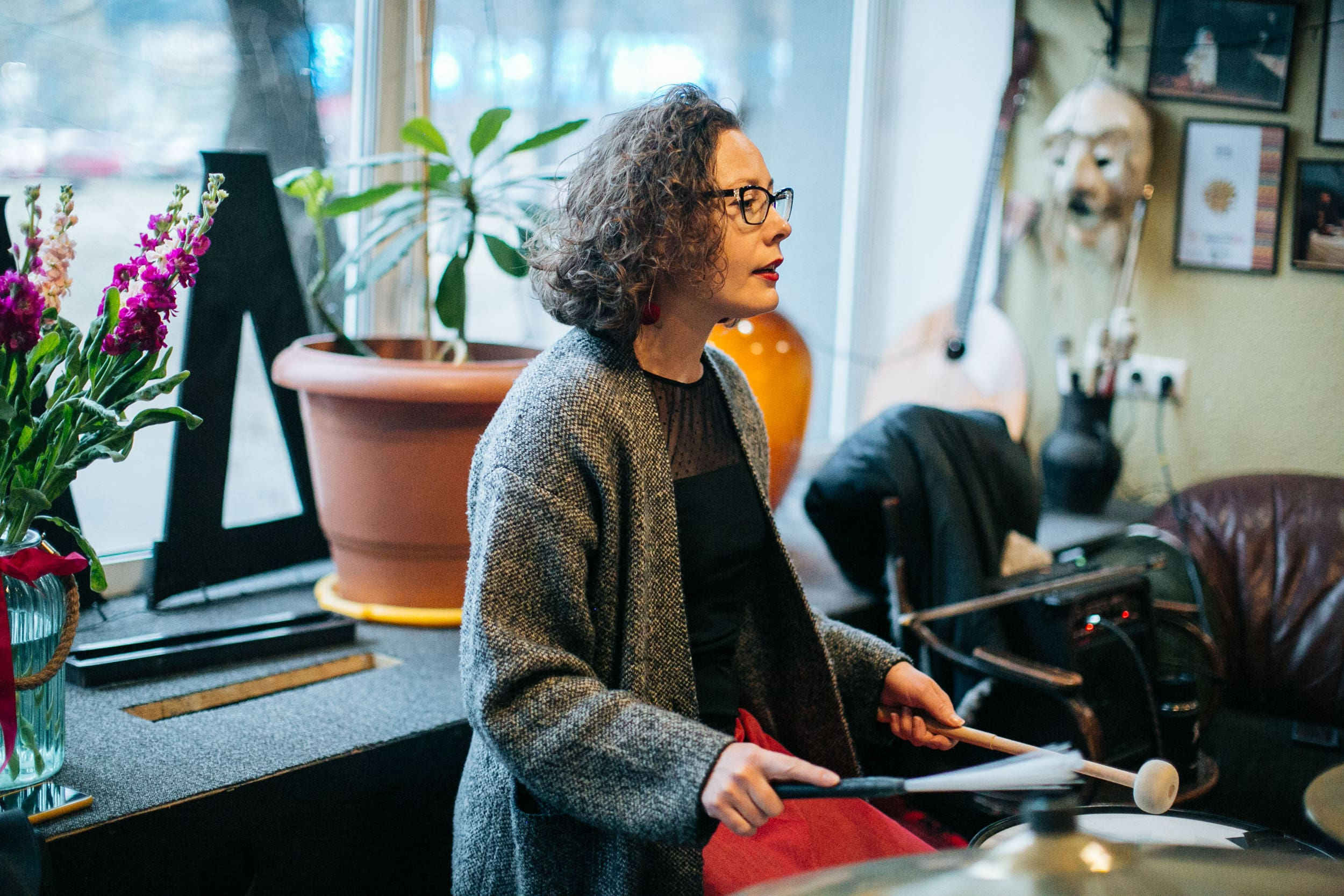
Olena
— You spend a lot of time abroad. Do you notice that Ukraine is changing?
— There are definitely changes, and they’re for the better. This applies to all spheres of life: firstly, the roads are constantly being repaired. Everything is improving. There are improvements in the educational system. My child started school, and I see that the new system suits me better. There are improvements everywhere, you just need to see them instead of repeating that all is lost, and that it’s a disgrace. Everything depends on us.

The Ivan Honchar Museum was established from the private collection of the painter, sculptor and civic activist Ivan Makarovych Honchar after his death in 1993.
It’s a centre for ethnological research as well as a museum, and also organises expeditions, conferences and cultural and artistic events. The museum forges connections with folk artists, guardians of traditional culture, and researchers. The head of the centre, Petro Honchar, believes that the preservation of Ukrainian culture is crucially important, since it unites society not just from a geographical and spatial point of view, but over time: “The aim of the museum is not to build a collection but to create a concept through which to unite society in terms of cultural heritage. Ivan Honchar paid a high price for it. The museum has been prosecuted in various ways. After Ukraine became independent, the collection was handed to the state. The main idea of the museum is to allow our history and culture to be perceived in a more modern way. We have combined not just museum exhibits, but a non-material element. What makes us famous and unlike anyone else is that we’ve revived a lot of rites that are becoming popular again. It’s a living museum, living tradition, and the museum of the future.”
— When and how did you learn about the Ivan Honchar Museum?
— I came here for the first time about 15 years ago. It was a very unfamiliar place for me — not much was happening here yet. I just came to an exhibition, had a look and left. I began coming here more often around ten years ago. They hold interesting events on a regular basis. The people who work here are truly passionate about what they do, and DakhaBrakha has worked with the museum a number of times.

— What was your cooperation with the museum about?
— We’ve done five joint projects. The first one was called ‘Tomorrow is Christmas’, I think. We told stories about our family traditions, which we learned about and carried on ourselves. Then we created a calendar for the museum, did a photoshoot, and shot a video for the museum’s anniversary.
— Is it true that traditional folklorists aren’t always positive about DakhaBrakha’s work?
— For some reason, people always have an aggressive attitude to anything new, because they don’t like change. The same thing happened to us. People said we were ruining the songs, and they didn’t like the way we looked. Our hats attracted a lot of criticism: people were even saying things like, “take off your hats or you won’t be able to bear children”. There have been some odd complaints, but we keep on doing our thing because we like it.
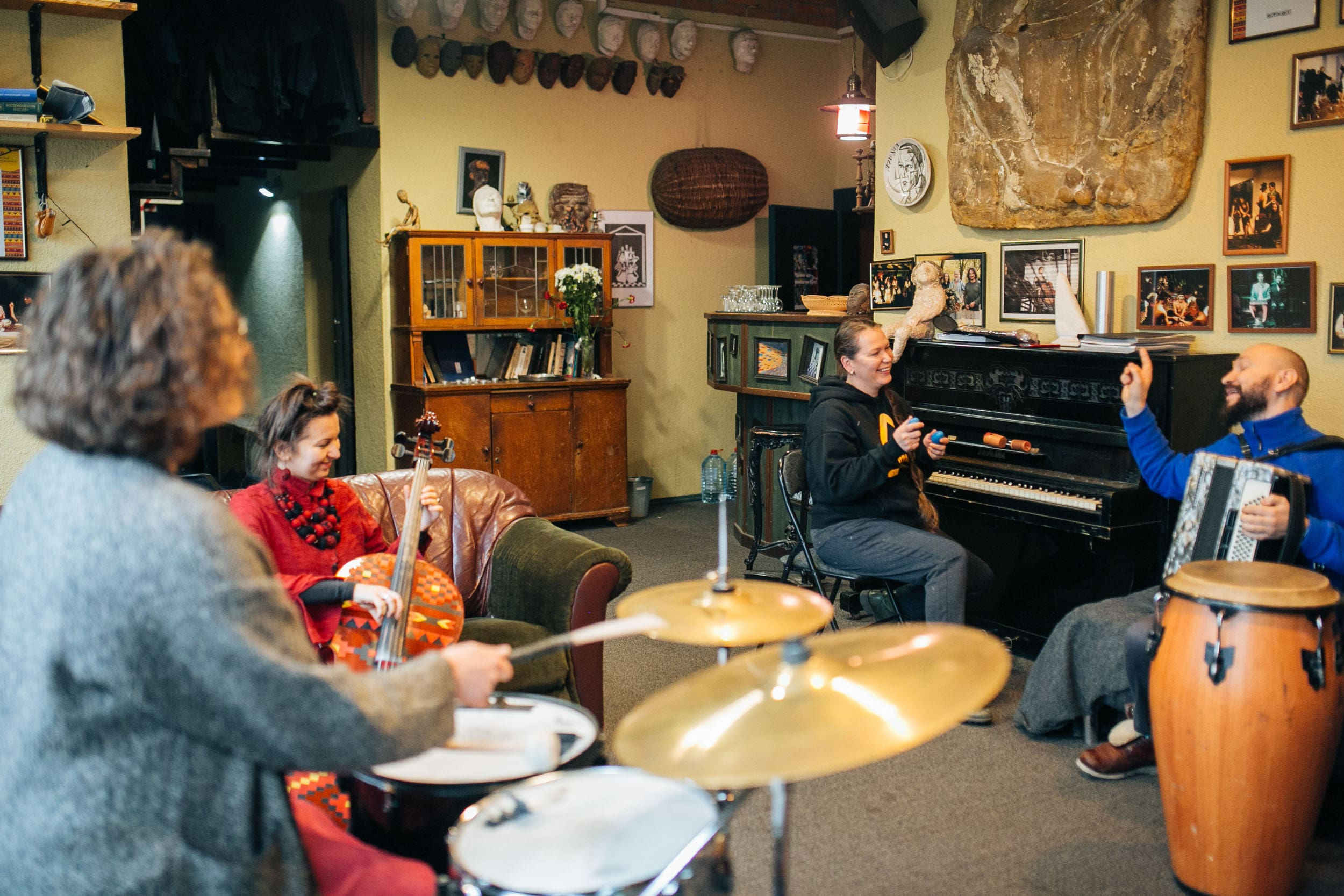
— Have you been on any ethnographic expeditions?
— Yes, during my student years. Today, unfortunately, I don’t have time for those trips, but there are experts, our colleagues and teachers, who still continue to travel around collecting. For almost 15 years now, we’ve been using what our friends and colleagues collected earlier.
— Does Vlad Troitskyi still have a big influence on DakhaBrakha’s art?
— At the beginning, he had a bigger influence. We work less with him now, but he still has the final word. If we’ve come up with a composition and got it to the stage when it’s listenable, we let Vlad listen. Then we either take his corrections into account, or we say “well, we prefer it our way”. That happens sometimes, too. At first, he didn’t like the track ‘Sho z-pid duba’ (‘From under the oak’ — tr.). He said that you couldn’t even call it a song. Then, after a while, we heard that he had it as his mobile ringtone, and realised there was something special about this composition.

The National Oleksandr Dovzhenko Centre was founded in 1994, on the site of the biggest film factory in Soviet Ukraine. Nowadays the Centre is a prominent cultural institution with an extensive international representation. In 2015, the premises of the Dovzhenko Centre were turned into an open public environment and an ‘art cluster’ was set up to unite citizenship initiatives in the modern art sphere. The Centre consists of a modern film archive, a film copying laboratory, the Museum of Cinema, a paper archive, a media centre and a publishing house.
Ivan Kozlenko, the Dovzhenko Centre’s executive director, believes that this institution, formerly closed to the public, deserves a second life: “The Centre’s entire premises used to be mostly industrial — it was one big workshop. We dismantled almost everything, because there were a lot of walls. It was an old Soviet habit to break any space into smaller nooks and crannies. It was a restricted-access facility, guarded by police, because silver is a by-product of the film development process. When we arrived here, there was nothing more to guard, but access was still restricted. Our objective was to make the institution transparent, in a literal sense. So we tore down all the walls on the first floor and created a spacious lobby. Now you can come here to the museum or the theatre.”
— What do you think about Ukrainian films?
— The last film I saw was ‘Dodomu’ (‘Homeward’, a 2019 Ukrainian drama film directed by Nariman Aliev — ed.). I’m so proud that there’s a film industry in Ukraine, and that it’s on that level.
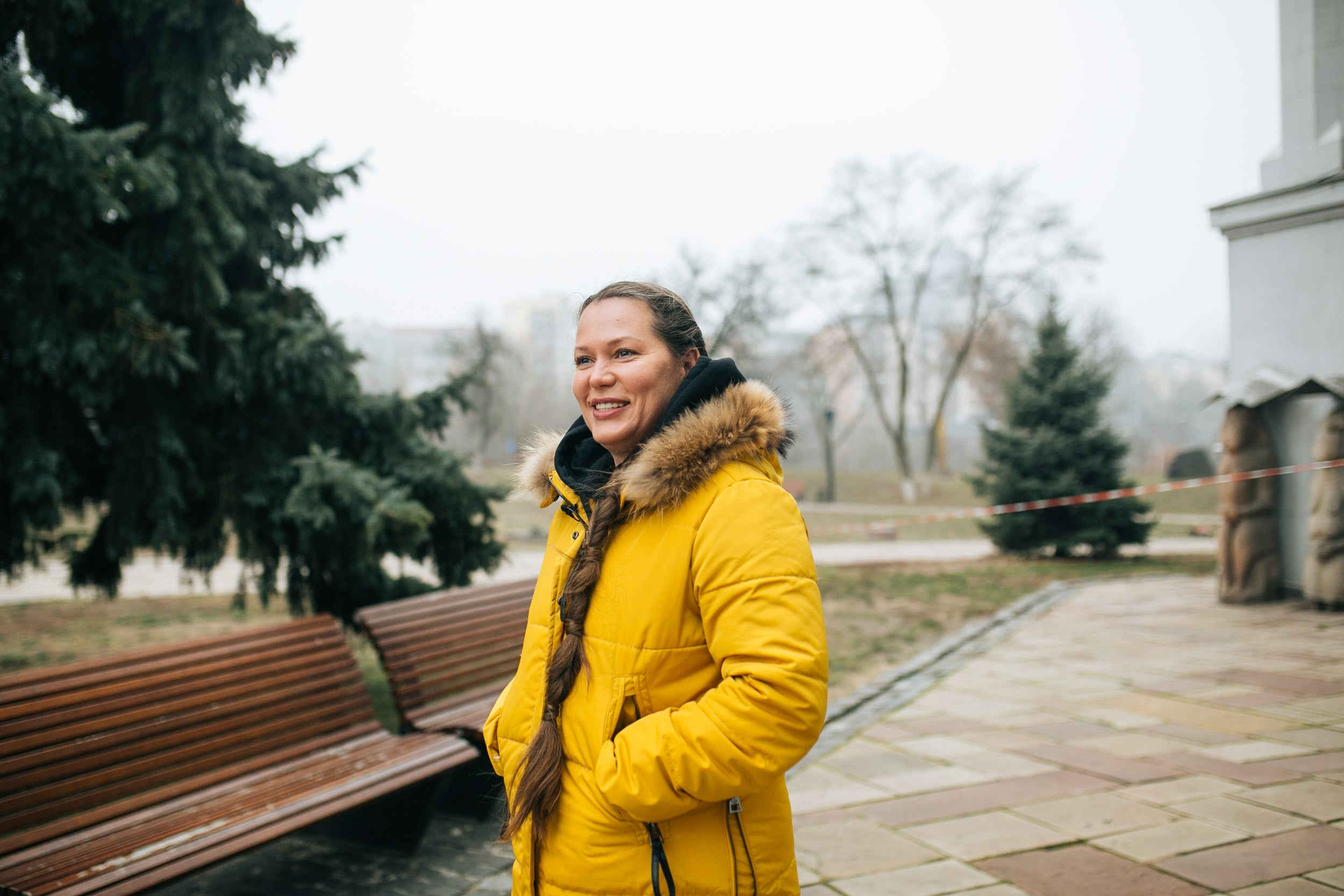
Iryna
— What does Kyiv mean to you?
— It’s my home. It’s the place where I was born, and where my parents live, as well as my friends and loved ones. But I mostly live in between worlds: on the plane, on the move, on the road.
— What memories do you have from childhood?
— I think of spring, birds singing, us going for a walk in the countryside. My dreams are connected with the place where I was born, where my school is, where I began singing in a choir. Once an ensemble came to our school and the children were singing spring songs, all dressed up in colourful ribbons, and they looked so vivid in their costumes. I came home and said: “Mum, I want to sing and dance,” and my mother agreed at once. So I went to that arts centre and was involved in pretty much all the activities. I had an interesting childhood; I hardly ever stayed at home. My dream was to study at the university of culture, then to become a singer. While I was a student we used to go to the Dakh Theatre. We tried to do something with Vlad Troitskyi. We sang there; at that point, DakhaBrakha was hardly even a twinkle in his eye. But it was interesting — we experimented, and created something exciting using folklore.

— Did you study at the university of culture?
— Yes, all the girls from DakhaBrakha studied there, one by one: Olenka was the first, then me, and Nina was the third, but we took it in turns to wait for each other. Our folklore mother Oksana Ivanivna Milevska used to call us “the asphalt kids”. She said it was a miracle that children born in a Ukrainian city were interested in folklore, were living and breathing it.
— When DakhaBrakha perform abroad, they represent Ukraine. A lot of people get their first impression of Ukraine from you. What does that mean to you?
— To be honest, I’ve never thought about it. I’m proud to have the opportunity to show what we can do, and people love it. All over the world, people know from the news that the country is going through a difficult period, and we get a lot of support. Especially when Marko hoists the flag at the end of the concert, and we feel a wave of emotion from the audience. You feel the sparks in your soul.

The restaurant ‘Sto rokiv vpered’ (‘One hundred years ahead’), founded by the chef Yevheniy Klopotenko, opened its doors in March 2019 in Kyiv. Its slogan, “leave your stereotypes behind”, is a warning to the public that the restaurant will overturn the traditional perception of Ukrainian cuisine, that it’s fatty and bland. While preparing to launch the restaurant, the team consulted with historians and researchers of regional cuisine, and studied recipe books. The restaurant’s concept and aim is to create new traditions in Ukrainian cuisine with the help of modern cooking techniques.
Yevhen Klopotenko is also helping to implement the state programme to reform the school meals system: recipes from obsolete Soviet cookbooks are being replaced with dishes rich in nutrients, to favour children’s health and physical development.
In the restaurant, the chef doesn’t offer foreign ingredients cooked the Ukrainian way. He believes that a satisfying product can be created in Ukraine, using local ingredients: “Everyone looks at Ukraine from a historical point of view, but I always examine what people were eating. I talk to people; they send me letters and share their family recipes. Once, on our way to the mountains, we asked our driver what he ate. And he said, ‘Nothing special, I take potatoes and add poppy seeds.’ That surprised us: ‘Potato? Poppy seeds? Wow!’ That’s how I collect recipes. I don’t care what people do for a living, but I do care what they eat and how they came up with their recipes. Everyone thinks Ukraine is all about salo, borshch and varenyky. In our restaurant, these dishes are mostly for foreigners. If a foreigner comes to our restaurant and asks in English for borshch, then we serve them borshch. If not, we don’t offer it. We have other options!’”
— What kind of music do you listen to?
— I like to listen to something new and fresh, recently released. But I usually don’t listen to much music: I don’t have time for it. I like to sit in a quiet place, go for a walk and listen to nature, to the birds. I can listen to a lot of folk music — I enjoy it and it really inspires me. Even when I listen to my own recordings — from my student years or my childhood — I think, “How wonderful!”

— Do you still perform in the theatre?
— No. I had a go at performing in the Dakh Theatre. I managed to do it, but didn’t enjoy it much. It was a play called ‘Anna’ by a Russian playwright, Klavdiev. I played the part of a prostitute. It was interesting, set deep in the Russian countryside. That was a difficult play. Perhaps I should have started with lighter genres. I was hurt that some people thought I was drunk, as if I felt free while playing that role, as if it was very easy to create that character. In fact, it was very scary, very tough. That’s why I can’t act: I feel everything too intensely.
— But as part of DakhaBrakha, you took part in performances more often, right?
— We played the soundtrack for various performances, that’s a different story: you just sit, play, and watch what’s happening next to you. We did the prologue to ‘Macbeth’, ‘Richard III’, ‘King Lear’ and the play ‘Dreams of the Lost Road’. Those were musical projects. When people ask me to come onstage and tell a story, it’s easier for me to say: “Can I sing something and not talk?” It’s easier for me to express everything in songs.
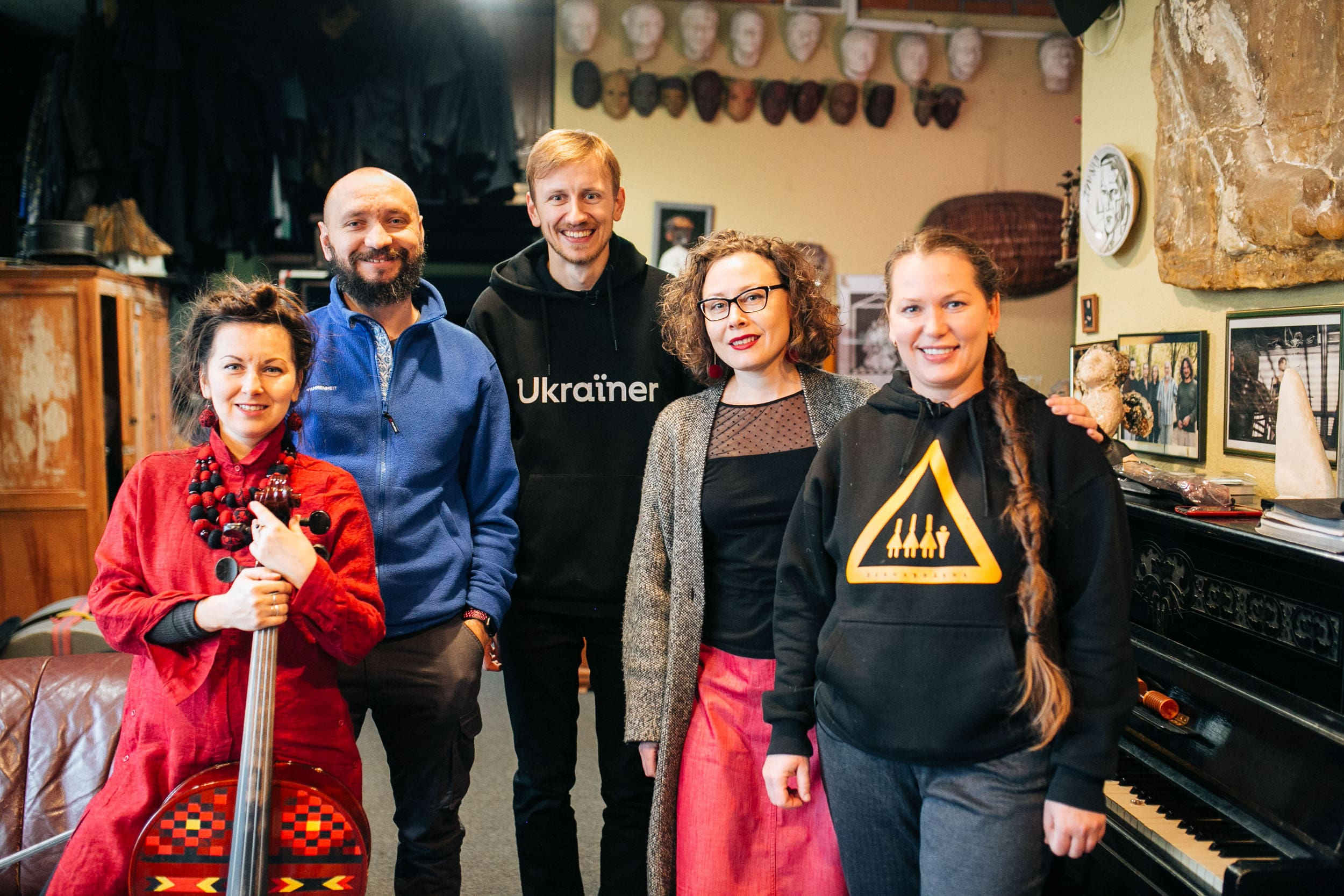
— How long did it take for DakhaBrakha to take shape?
— I think it took up to a year and a half before we realised that we could have a concert at the Dakh Theatre without accompanying any performance, just our own songs.
— What is the Dakh Theatre for you personally?
— It’s a temple of art. We’ve spent a lot of time there, and these days, now that it attracts a lot of people and different projects, I feel like there’s a crowd of people in my home, and it annoys me. Back then, there was nobody but us, and we felt at home there. Now it’s an arts centre, and we’re just one of the many projects that have come out of it.

